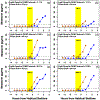Evening Light Intensity and Phase Delay of the Circadian Clock in Early Childhood
- PMID: 36415902
- PMCID: PMC11302507
- DOI: 10.1177/07487304221134330
Evening Light Intensity and Phase Delay of the Circadian Clock in Early Childhood
Abstract
Late sleep timing is prevalent in early childhood and a risk factor for poor behavioral and health outcomes. Sleep timing is influenced by the phase of the circadian clock, with later circadian timing linked to delayed sleep onset in young children. Light is the strongest zeitgeber of circadian timing and, in adults, evening light produces circadian phase delay in an intensity-dependent manner. The intensity-dependent circadian phase-shifting response to evening light in children, however, is currently unknown. In the present study, 33 healthy, good-sleeping children aged 3.0 to 4.9 years (M = 4.14 years, 39% male) completed a 10-day between-subjects protocol. Following 7 days of a stable sleep schedule, an in-home dim-light circadian assessment was performed. Children remained in dim-light across 3 days (55 h), with salivary melatonin collected in regular intervals throughout each evening. Phase-shifting effects of light exposure were determined via changes in the timing of the dim-light melatonin onset (DLMO) prior to (Day 8) and following (Day 10) a light exposure stimulus. On Day 9, children were exposed to a 1 h light stimulus in the hour before their habitual bedtime. Each child was randomly assigned to one intensity between 5 and 5000 lux (4.5-3276 melanopic EDI). Across light intensities, children showed significant circadian phase delays, with an average phase delay of 56.1 min (SD = 33.6 min), and large inter-individual variability. No relationship between light intensity and magnitude of the phase shift was observed. However, a greater percentage of melatonin suppression during the light exposure was associated with a greater phase delay (r = -0.73, p < 0.01). These findings demonstrate that some young children may be highly sensitive to light exposure in the hour before bedtime and suggest that the home lighting environment and its impact on circadian timing should be considered a possible contributor to behavioral sleep difficulties.
Keywords: child development; circadian rhythm; light; phase delay; preschool; sleep.
Figures






Similar articles
-
The Circadian Response to Evening Light Spectra in Early Childhood: Preliminary Insights.J Biol Rhythms. 2025 Apr;40(2):181-193. doi: 10.1177/07487304241311652. Epub 2025 Jan 8. J Biol Rhythms. 2025. PMID: 39773135 Free PMC article.
-
High sensitivity of melatonin suppression response to evening light in preschool-aged children.J Pineal Res. 2022 Mar;72(2):e12780. doi: 10.1111/jpi.12780. Epub 2022 Jan 8. J Pineal Res. 2022. PMID: 34997782 Free PMC article.
-
The Timing of the Circadian Clock and Sleep Differ between Napping and Non-Napping Toddlers.PLoS One. 2015 Apr 27;10(4):e0125181. doi: 10.1371/journal.pone.0125181. eCollection 2015. PLoS One. 2015. PMID: 25915066 Free PMC article.
-
Electric lighting, adolescent sleep and circadian outcomes, and recommendations for improving light health.Sleep Med Rev. 2022 Aug;64:101667. doi: 10.1016/j.smrv.2022.101667. Epub 2022 Aug 12. Sleep Med Rev. 2022. PMID: 36064209 Free PMC article. Review.
-
Why the dim light melatonin onset (DLMO) should be measured before treatment of patients with circadian rhythm sleep disorders.Sleep Med Rev. 2014 Aug;18(4):333-9. doi: 10.1016/j.smrv.2013.12.001. Epub 2013 Dec 10. Sleep Med Rev. 2014. PMID: 24388969 Review.
Cited by
-
Sleep Across the Lifespan: A Neurobehavioral Perspective.Curr Sleep Med Rep. 2025;11(1):7. doi: 10.1007/s40675-025-00322-2. Epub 2025 Feb 5. Curr Sleep Med Rep. 2025. PMID: 40538866 Free PMC article. Review.
-
The Circadian Response to Evening Light Spectra in Early Childhood: Preliminary Insights.J Biol Rhythms. 2025 Apr;40(2):181-193. doi: 10.1177/07487304241311652. Epub 2025 Jan 8. J Biol Rhythms. 2025. PMID: 39773135 Free PMC article.
-
Mapping the physiological changes in sleep regulation across infancy and young childhood.PLoS Comput Biol. 2024 Oct 21;20(10):e1012541. doi: 10.1371/journal.pcbi.1012541. eCollection 2024 Oct. PLoS Comput Biol. 2024. PMID: 39432549 Free PMC article.
-
Creating the Cave: Conducting Circadian Science in Early Childhood.Clocks Sleep. 2023 Feb 20;5(1):85-93. doi: 10.3390/clockssleep5010009. Clocks Sleep. 2023. PMID: 36810846 Free PMC article.
-
Nocturnal Smartphone Use Affects Sleep Quality and Cognitive and Physical Performance in Tunisian School-Age Children.Eur J Investig Health Psychol Educ. 2024 Mar 28;14(4):856-869. doi: 10.3390/ejihpe14040055. Eur J Investig Health Psychol Educ. 2024. PMID: 38667810 Free PMC article.
References
-
- Beltramini AU and Hertzig ME (1983) Sleep and bedtime behavior in preschool-aged children. Pediatrics 71(2):153–158. - PubMed
-
- Boivin DB, Duffy JF, Kronauer RE, Czeisler CA (1996) Dose-response relationships for resetting of human circadian clock by light. Nature 379(6565):540–542. - PubMed
-
- Bruni O, Reto FL, Miano S, Ottaviano S (2000) Daytime behavioral correlates of awakenings and bedtime resistance in preschool children. Suppl Clin Neurophysiol 53:358–361. - PubMed
Publication types
MeSH terms
Substances
Grants and funding
LinkOut - more resources
Full Text Sources

